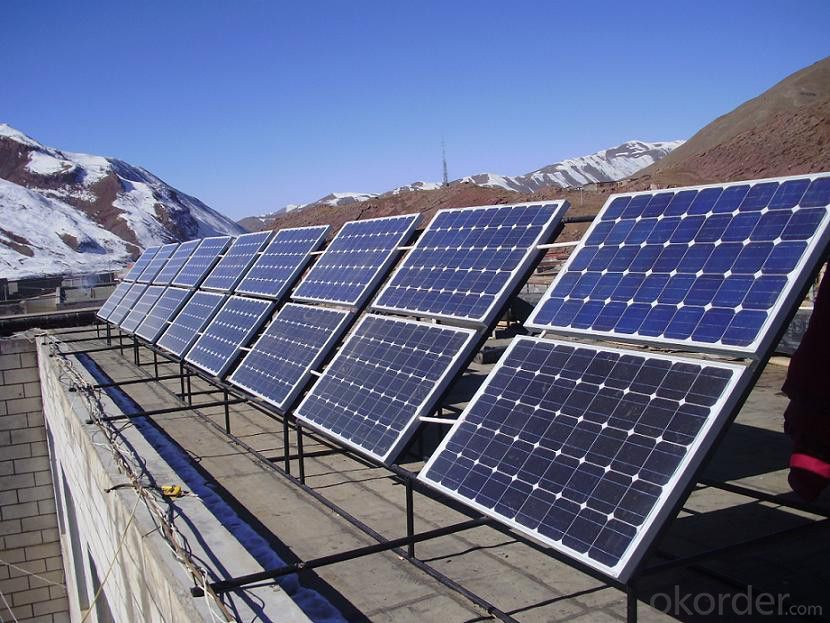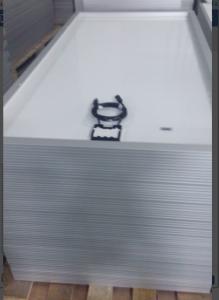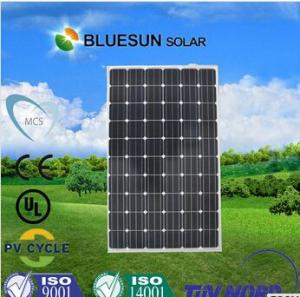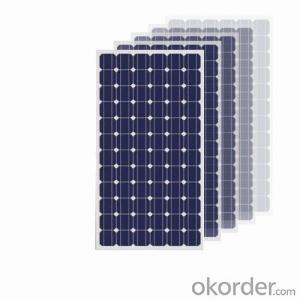Kent Solar Panels 230W Monocrystalline Silicon Solar Module
- Loading Port:
- China main port
- Payment Terms:
- TT OR LC
- Min Order Qty:
- 100000 watt
- Supply Capability:
- 10000000 watt/month
OKorder Service Pledge
OKorder Financial Service
You Might Also Like
Quality Certificates
IEC61215, IEC61730, IEC62716, IEC61701, UL1703, ETL, JET, CE, MCS,
CEC, Israel Electric, Kemco
ISO9001:2008: Quality management system
ISO14001:2004: Environmental management system
OHSAS18001:2007: Occupational health and safety management system
Amerisolar’s photovoltaic modules are designed for large electrical power requirements. With a 30-year warranty, AS-6P offers high-powered, reliable
performance for both on-grid and off-grid solar projects.

Key features:
Low degradation and excellent performance under high temperature and low
light conditions.
Robust aluminum frame ensures the modules to withstand wind loads up to
2400Pa and snow loads up to 5400Pa.
Positive power tolerance of 0 ~ +3 %.
High ammonia and salt mist resistance.
Mono 230w with high module conversion efficiency and high quality. Meanwhile all panels have positive power tolerance of 0 ~ +3 %.
FAQ:
Q1: Why buy Materials & Equipment from OKorder.com?
A: All products offered byOKorder.com are carefully selected from China's most reliable manufacturing enterprises. Through its ISO certifications, OKorder.com adheres to the highest standards and a commitment to supply chain safety and customer satisfaction.
Q2: What is a solar PV module?
A: A solar PV module consists of many solar cells that are connected together (typically in series) and packaged in a frame (typically made of aluminum).
Q3: What are the advantages and disadvantages of monocrystalline solar PV modules?
A: Monocrystalline solar PV modules are the most efficient type of solar PV modules, with the exception of CdTe thin film solar PV modules. As a result, monocrystalline solar PV modules are more expensive when compared to almost all other types of solar PV modules.
- Q: can anyone help me? i was thinking of installing solar panels to cut bills but would it be a waste considering its gonna need a circulating pump running almost 24/7 (which will use electricity) and even still will only provide me with quot;warmwater? also would it be possible to install the solar panels for the sole purpose of providing sufficient power to run electric heaters instead of using gas/oil? this way allowing me to have a warm house without the expensive bills. brobably talking about running 7 heaters/electric radiators.
- A thermal solar panel to feed your water heater is the most efficient. But you need a classic heater system too when there is no or little sun. Solar panels to heat a home is not at all recommended. First of all, you get less day light and less sun in winter, so you won't get much electricity. They work best in summer, but electric panels have poor yields and are a very long term investment. You will need to wait years before saving money. Natural gas, a well isolated home, and a good old sweater is the best way to cut bills.
- Q: Can solar panels be used for powering a marina or boating facility?
- Yes, solar panels can be used to power a marina or boating facility. Solar energy can provide a reliable and sustainable source of power for various applications such as lighting, charging stations, refrigeration, and other electrical needs in a marina or boating facility. By harnessing the sun's energy, solar panels can significantly reduce dependency on traditional electricity sources, lower operating costs, and promote environmental sustainability.
- Q: Can solar panels be installed on schools or universities?
- Yes, solar panels can definitely be installed on schools or universities. In fact, many educational institutions are increasingly adopting solar energy as a sustainable and cost-effective solution to meet their electricity needs. By installing solar panels, schools and universities can reduce their carbon footprint, save money on energy bills, and provide a valuable educational opportunity for students to learn about renewable energy.
- Q: I'm looking to mount a solar panel to the top of my 2003 Pontiac Montana and was wondering how i could do it without any screws? Magnets maybe?
- Build okorder /
- Q: i already have solar/gas water heating, but was wondering if getting solar panels for electricity installed was a good idea.
- Create okorder
- Q: I am looking to get some solar panels for my home to just power a few lights, a fan or two. I have a generator but I want that only to power the fridge and maybe some other small stuff for convenience.But mainly want the solar panels for the lights and fans. Any one have an idea of how about I go to figuring this all out? Should I call a contractor or anything?
- depends on what light bulbs you have in watts.depends on how many you want on. for the power equation you take P which equals watts x I which equals amps and E which equals volts and you multiply the amps and the volts together to get the watts which the solar panel is generating. for example if you had 7 60 watt light bulbs you would need 420 watts generated. which if you got 50 watt panels each you would need 9 panels. and for what your talking about if you want the stuff to work when the power goes out you are going to need an inverter. not to be confused with a grid ti inverter. and a few batteries i recommend deep cycle batteries that are meant for solar panels. depends on what fan you have.
- Q: I'm doing a project for school and I'm a little confused about energy and solar panels. I'm looking to propose installation of solar panels to power the computer lab at my school. From what I've read a computer and monitor use roughly 350 watts per hour. I was looking at solar panels and it says they produce various wattage. For example, I was looking at one rated at 200 watts. Does that mean 200 watts in a day? Or per hour? Please help.
- The rating of a solar panel is a maximum continuous rating. A 200 Watt panel will give a maximum of 200 watts under ideal conditions. A computer and monitor use about 400 Watts. not per hour - watts is Volts * Amps and a measure of Power. In hour a computer and monitor uses 400 Watt hours (Wh). Wh is a measure of Energy. To power a lab of 0 computers you will need 0* 400 = 4000 Watts. To run this from solar panels through the day only you would need a 4000 Watt panel. Except - its cloudy, the sun is in the wrong place - many factors reduce the output. To be reasonably safe you would need about a 2000 Watt panel. Then you would need batteries to store power through dull periods AND a voltage converter to change from low voltage DC from the solar panels to the mains voltage for your computers.
- Q: I've been reading up on Solar panels because I think in the long run this would be beneficial in the long run. My Dad had looked into it before passing and had said it was too expensive. How much does it range for getting them placed on the roof and how exactly does that work? I think I remember being told that PGE has incentives and could possibly even end up paying you for having it? What does having panels cover? I know electricity but does it also heat things up? Sorry I'm kinda dee dee dee on this lol. Any and all information would be greatly appreciated. If anyone has solar panels can I get your experiences with them? Thanks!!
- The solar panels that we all simply would think are the greatest thing ever are very, very expensive and require strip mining of huge areas of land to make. For several million dollars you can buy what usually is mounted as power source for space satellites upon your roof. This 2'x2' panel and a barrage of battery storage takes care of all the electrical needs you could ever have at home. But this profoundly environmentally destructive technology is not what you had in mind, I'm sure, but is what has been around for quite some time now. It's been a challenge to make solar panels without using complex chains of excited rare metallurgies, but we seem to be getting better and better at it--but I trust others should help you with the practical, now that you know the best panels are not best for us at home.
- Q: Can solar panels be installed on a school or educational institution?
- Yes, solar panels can be installed on a school or educational institution. In fact, many schools around the world are increasingly adopting solar energy systems as a sustainable and cost-effective solution to meet their energy needs. Installing solar panels on educational institutions not only helps reduce their carbon footprint but also serves as an educational tool, allowing students to learn about renewable energy and environmental conservation firsthand.
- Q: when building a solar panel should the diode be on the positive or negative sidelittle more detail i just built a solar panel and im running it to a grid tie converter should i put diodes in if i add another panel or are they only for battery systems?
- Bypass diodes would be in parallel with groups of solar cells in a panel. For example, if a module has 72 cells, maybe every 8 cells, there will be a bypass diode. A bypass diode does nothing except salvage some of the energy from the panel if some of the cells are shaded, and others are not. Or, if you have multiple panels in a series string, the bypass diodes allow the other panels in a string to continue to contribute energy when one panel is shaded. Unless you're forced to put the panel(s) where there will be shade during the day, the bypass diode does not matter. Commercial panels all include bypass diodes. Blocking diodes are generally NOT included on commercial panels. If you're going to a grid-tied inverter, you probably don't need one. There are stringent regulations on how panels must be grounded, and whichever side of the panel is grounded should not have a blocking diode. NEC regulations call for a continuous ground to earth. For example, if you have negative ground on your system, the blocking diodes, if any, should go on the positive terminal of the panel. By the way, if you're in the US or Canada, do understand that a home-built panel will not be legal to connect to a grid-tied system. And a grid-tied inverter that plugs into the wall will also be illegal. I'm only saying this because I don't want you to get hurt, or your house to burn down. Line power is nothing to be trifled with.
Send your message to us
Kent Solar Panels 230W Monocrystalline Silicon Solar Module
- Loading Port:
- China main port
- Payment Terms:
- TT OR LC
- Min Order Qty:
- 100000 watt
- Supply Capability:
- 10000000 watt/month
OKorder Service Pledge
OKorder Financial Service
Similar products
Hot products
Hot Searches
Related keywords




























